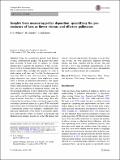Files in this item
Insights from measuring pollen deposition : quantifying the pre-eminence of bees as flower visitors and effective pollinators
Item metadata
| dc.contributor.author | Willmer, Patricia Gillian | |
| dc.contributor.author | Cunnold, Helen Elizabeth | |
| dc.contributor.author | Ballantyne, Gavin Andrew | |
| dc.date.accessioned | 2017-05-11T16:30:09Z | |
| dc.date.available | 2017-05-11T16:30:09Z | |
| dc.date.issued | 2017-06 | |
| dc.identifier | 249730850 | |
| dc.identifier | fbf458b6-5fe0-4bd9-ad36-e395602fcd85 | |
| dc.identifier | 85018772592 | |
| dc.identifier | 000401742400018 | |
| dc.identifier.citation | Willmer , P G , Cunnold , H E & Ballantyne , G A 2017 , ' Insights from measuring pollen deposition : quantifying the pre-eminence of bees as flower visitors and effective pollinators ' , Arthropod-Plant Interactions , vol. 11 , no. 3 , pp. 411-425 . https://doi.org/10.1007/s11829-017-9528-2 | en |
| dc.identifier.issn | 1872-8855 | |
| dc.identifier.uri | https://hdl.handle.net/10023/10755 | |
| dc.description | This research was funded by the Natural Environmental Research Council (grant no. NE/K004522/1), and by a St Andrews University Research studentship (HC). | en |
| dc.description.abstract | Using our accumulated datasets from Kenyan savanna, Mediterranean garigue, UK gardens and heathland, involving 76 plants from 30 families, we present detailed data to quantify the superiority of bees as pollinators of most flowering plants when compared with other flower visitors. Bees provided the majority of visits to study species at all sites, and 33 of the 76 plants received more than 90% of their visits from bees. Furthermore, pollen deposition onto stigmas from single-visit events (SVD, a measure of pollination effectiveness) was significantly higher for bees than non-bees at all the four sites where a major proportion of the flora was sampled. Solitary bees, and also bumblebees in temperate habitats, were the best potential pollinators for most plants in this respect, and significantly out-performed honeybees. Only a few plants were well served by bombyliid flies, and fewer again by larger hoverflies, butterflies, or solitary wasps. Bees also achieved better matches of their visit timing to peak pollen availability (measured indirectly as peak SVD), and made much shorter visits to flowers than did non-bees, permitting a substantially greater visit frequency. Additionally, they deposited significantly lower levels of potentially deleterious heterospecific pollen on stigmas in heathland and Mediterranean garigue, though not in the UK garden with densely clustered high-diversity flowering, or in the Kenyan savanna site with particularly dispersed flowering patches and some specialist non-bee flowers. Our data provide a novel and quantified characterisation of the specific advantages of bees as flower visitors, and underline the need to conserve diverse bee communities. | |
| dc.format.extent | 15 | |
| dc.format.extent | 588463 | |
| dc.language.iso | eng | |
| dc.relation.ispartof | Arthropod-Plant Interactions | en |
| dc.subject | Pollination | en |
| dc.subject | Pollen deposition | en |
| dc.subject | Bees | en |
| dc.subject | Flower visit duration | en |
| dc.subject | Visit timing | en |
| dc.subject | Heterospecific pollen | en |
| dc.subject | GE Environmental Sciences | en |
| dc.subject | QH301 Biology | en |
| dc.subject | NDAS | en |
| dc.subject.lcc | GE | en |
| dc.subject.lcc | QH301 | en |
| dc.title | Insights from measuring pollen deposition : quantifying the pre-eminence of bees as flower visitors and effective pollinators | en |
| dc.type | Journal article | en |
| dc.contributor.sponsor | NERC | en |
| dc.contributor.institution | University of St Andrews. School of Biology | en |
| dc.contributor.institution | University of St Andrews. Scottish Oceans Institute | en |
| dc.contributor.institution | University of St Andrews. Institute of Behavioural and Neural Sciences | en |
| dc.contributor.institution | University of St Andrews. St Andrews Sustainability Institute | en |
| dc.identifier.doi | https://doi.org/10.1007/s11829-017-9528-2 | |
| dc.description.status | Peer reviewed | en |
| dc.identifier.grantnumber | NE/K004522/1 | en |
This item appears in the following Collection(s)
Items in the St Andrews Research Repository are protected by copyright, with all rights reserved, unless otherwise indicated.

